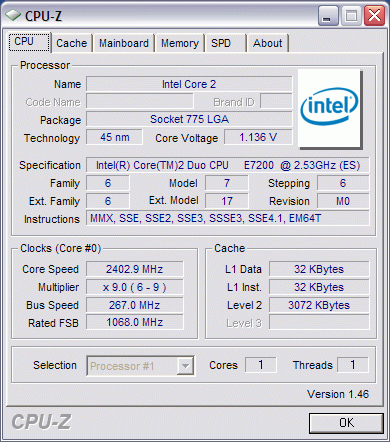Intel Wolfdale vs. AMD Agena
|
We proceed with our series of reviews devoted to analyzing various factors that affect performance of modern x86-64 processors. In this review we'll try (as far as it's possible) to answer the question about performance of a single processor core in comparison with two main competitors. For this purpose we'll use two LGA775 and Socket AM2+ motherboards -- Biostar TPower I45 (IP45A-A7P) and ASUS M3A32-MVP Deluxe/WiFi-AP -- that allow disabling all CPU cores but one in BIOS.
Some of you may be surprised that we modified our LGA775 testbed. ASUS Maximus Extreme was replaced with a less functional motherboard, not with the top chipset at that. First of all, it was done to provide identical operating conditions for both cores: the motherboard from BIOSTAR works with the same DDR2-800 memory as our standard platform for Socket AM2+. Besides, ASUS Maximus Extreme cannot disable cores in Core 2 processors, that's another reason to replace the testbed for these tests.
 
As you can see, operating conditions are practically identical: only one core is working, memory type/frequency/timings match, core frequencies are identical as well (in case of the LGA775 platform, we had to use the feature of Core 2 Duo E7200 engineering sample to change its multiplier to a custom value). Meticulous but hasty readers may ask a question about the cache. Wolfdale core has a 3-MB L2 cache (which in this case is used only by a single core), while Agena (represented by Phenom X4 9850 Black Edition) has only a 2-MB L3 cache.
However, it's not as bad as it seems. Don't forget that Intel processors come with non-exclusive caches. So maximum volume of cached data is determined by a cache of the maximum size. And the AMD platform comes with exclusive cache (L3 is adaptive-exclusive, but theoretically, it should work as exclusive cache in case of a single core). Thus, maximum volume of cached data is actually the sum of cache sizes of all levels. In our case it's 128 (L1) + 512 (L2) + 2048 (L3) = 2688 KB. It's smaller than the 3072-KB L2 in Wolfdale by 13%. But it's the lesser evil, as the main competitors do not consult each other on the size of caches to facilitate our task.
Some of you may think that L2/L3 cache must be disabled to obtain ideal test conditions. It's a disputed point. Firstly, it's not a real-life situation -- nobody uses modern x86-64 processors with disabled L2 Caches. Secondly, in this very case the AMD core would have got a very serious advantage, as L1 Cache cannot be disabled (at least in BIOS Setup). And L1 Cache size in Agena is twice as big as in Wolfdale.
Write a comment below. No registration needed!
|
|
 |
|
|
|




